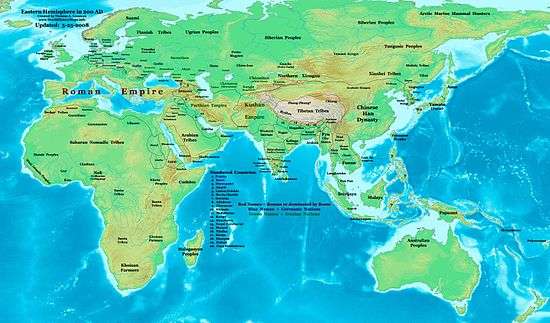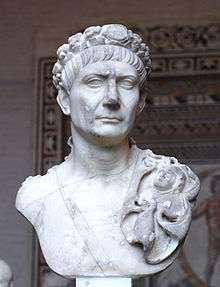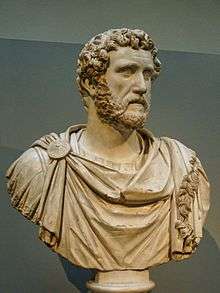2nd century
| Millennium: | 1st millennium |
|---|---|
| Centuries: | |
| Decades: | 100s 110s 120s 130s 140s 150s 160s 170s 180s 190s |
| Categories: | Births – Deaths Establishments – Disestablishments |


The 2nd century is the period from 101 to 200 in accordance with the Julian calendar in the Common Era. It is considered part of the Classical era, epoch, or historical period.
Early in the century, the Roman Empire attained its greatest expansion under the emperor Trajan, but after his death became primarily defensive for the rest of its history. Much prosperity took place throughout the empire at this time, ruled as it were by the Five Good Emperors, a succession of well-received and able rulers. This period also saw the removal of the Jews from Jerusalem during the reign of Hadrian after Bar Kokhba's revolt. The last quarter of the century saw the end of the period of peace and prosperity known as the Pax Romana at the death of the emperor Marcus Aurelius, last of the "Five Good Emperors", and the accession of Commodus.
Although the Han Dynasty of China was firmly cemented into power and extended its imperial influence into Central Asia during the first half of the century, by the second half there was widespread corruption and open rebellion. This set in motion its ultimate decline, until it was overthrown in 220.
Events

- 96 – 180: Five Good Emperors of Rome: Nerva, Trajan, Hadrian, Antoninus Pius, Marcus Aurelius.
- The Kingdom of Aksum emerges.
- 101 – 102, 105 – 106: The Dacian Wars. After two conflicts, Dacia is annexed as a Roman province.
- 114 – 116: A war with Parthia results in Armenia and Mesopotamia being temporarily annexed into the Roman Empire.
- 115 – 117: Kitos War, adjunct to the Jewish–Roman wars.
- 122 – 132: Hadrian's Wall across Northern England.
- 127 – 163: Kanishka, Kushan Ruler.
- 132 – 135: Bar Kokhba's revolt against Rome.
- 132: Chinese chronicles described the existence of diplomatic relations between Java and China.
- 140 – 180: Huvishka, Kushan ruler.
- 142: The Antonine Wall is built across central Scotland.
- 144: Marcion, rejected by Church of Rome, founds Marcionism.
- 161 – 166: Roman–Parthian War of 161–166.
- 165 – 180: The Antonine Plague in Rome.
- 166 – 180: Marcomannic Wars.
- 180 – 192: Commodus, Roman Emperor.
- 184 – 205: The Yellow Turban Rebellion of the Han Dynasty in China begins.
- 184 – 189: The Liang Province Rebellion breakouts in Northwest China.
- 189 – 220: The End of the Han dynasty.
- 190 – 191: Warlords across China launches a Campaign against Dong Zhuo.
- 193: Roman Year of the Five Emperors.
- 193 – 211: Septimius Severus, Roman Emperor.
- Herakleitos makes The Unswept Floor, mosaic variant of a 2nd-century BC painting by Sosos of Pergamon. It is now kept at the Musei Vaticani, in Rome.
- c. 2nd or 3rd century – Standing Buddha, from Gandhara (Pakistan), is made. Kushan period. It is now kept at Lahore Museum, Lahore.
Significant people
- Antoninus Pius, Roman Emperor
- Cai Yong, Chinese scholar
- Commodus, Roman Emperor
- Dong Zhuo, Chinese general, politician and warlord
- Hadrian, Roman Emperor
- Huvishka, Kushan Ruler
- Ignatius, third bishop of Antioch, author of letters
- Irenaeus, second bishop of Lyon, author of Against the Heresies
- Julia Domna, Empress of Rome
- Justin Martyr, Christian apologist
- Kanishka, Kushan ruler
- Kong Rong, Chinese scholar
- Lü Bu, Chinese general and warlord
- Lucius Verus, Roman Emperor
- Marcus Aurelius, Roman Emperor, philosopher
- Montanus, Christian heretic.
- Nagarjuna, founder of Madhyamaka Buddhism
- Polycarp, bishop of Smyrna.
- Rabbi Akiva, Head of the Jewish Sages
- Rabbi Yehuda haNasi, redactor of the Mishnah
- Septimius Severus, Roman Emperor
- Simon bar Kokhba, Jewish rebel leader
- Sun Ce, Chinese general and warlord
- Trajan, Roman Emperor
- Victor I, bishop of Rome.
- Vologases IV, Parthian ruler
- Vologases V, Parthian ruler
- Wang Yun, Chinese official
- Qiao Xuan, Chinese official
- Yuan Shao, Chinese warlord
- Yuan Shu, Chinese warlord
- Zhang Daoling, Chinese Taoist hermit.
- Zhang Heng, Chinese statesman, poet, inventor, astronomer, geographer, and engineer.
- Zhang Jue, Chinese rebel leader
- Zhang Zhongjing, one of the most famous Chinese physicians during Han Dynasty.
Literature
- Achilles Tatius, Greek writer
- Apuleius (Lucius Apuleius Madaurensis), Roman writer of Numidian origin
- Aulus Gellius, Roman writer and grammatician
- Chariton, Greek writer
- Juvenal Roman poet
- Longus, Greek writer
- Lucian of Samosata, Greek writer and rhetorician
- Pliny the Younger (Gaius Plinius Caecilius Secundus), Roman writer and lawyer
- Xenophon of Ephesus, Greek writer
Science and Philosophy
- Abascantus, Roman physician
- Apollodorus of Damascus, Greek engineer and architect
- Arrian, Greek-Roman historian
- Cai Lun, Chinese inventor
- Claudius Ptolemy, Greek astronomer, astrologer and geographer
- Epictetus, Greek philosopher
- Galen (Claudius Galenus), Greek physician
- Hua Tuo, Chinese physician
- Hyginus Gromaticus, Roman writer on land-surveying
- Ma Rong, Chinese scholar and writer
- Marcus Cornelius Fronto, Roman grammarian and rhetorician
- Ptolemy, Greco-Egyptian astronomer, astrologer, geographer and mathematician
- Plutarch, Greek philosopher, writer and historian
- Suetonius (Gaius Suetonius Tranquillus), Roman historian
- Tacitus (Gaius Cornelius Tacitus), Roman historian
- Valentinius, Roman philosopher
- Xu Shen, Chinese philogist
- Zheng Xuan, Chinese commentator and scholar
Inventions, discoveries, introductions
- 105: Cai Lun of China invents paper.
- Ptolemy compiles a catalogue of all stars visible to the naked eye. He also compiles three of the most influential books in western history:
- the Almagest which becomes the basis for western and Middle Eastern astronomy until the time of Nicolaus Copernicus and Johannes Kepler.
- the astrological treatise, Tetrabiblos.
- and the Geographia.
- 125: Zhang Heng of China invents the world's first water-powered armillary sphere.
- 132: Zhang Heng of China invents first seismometer to detect the cardinal direction of earthquakes.



